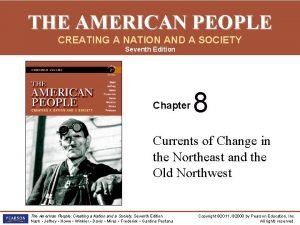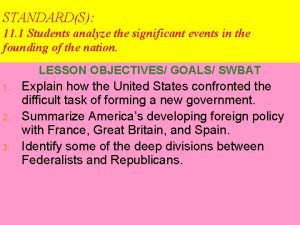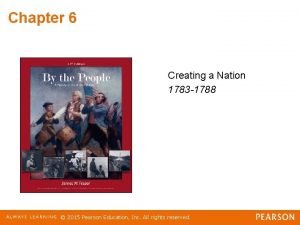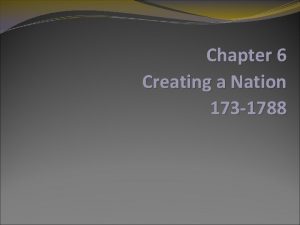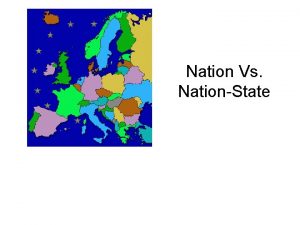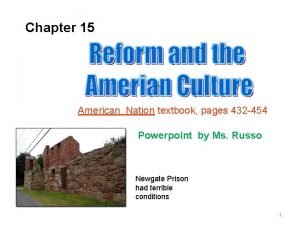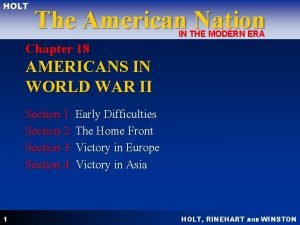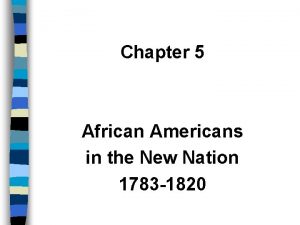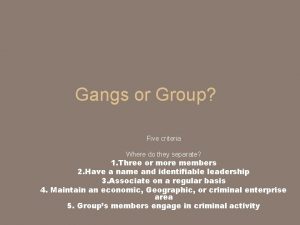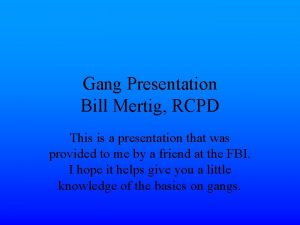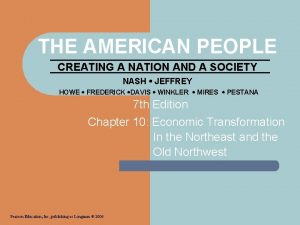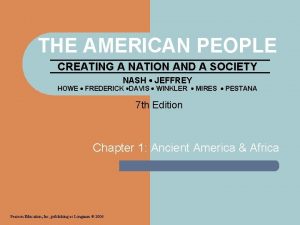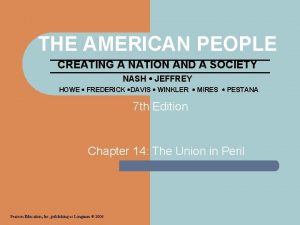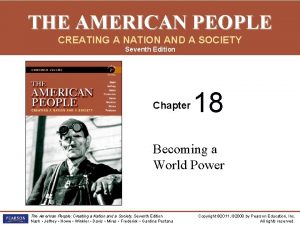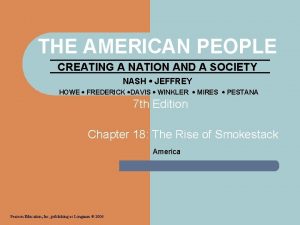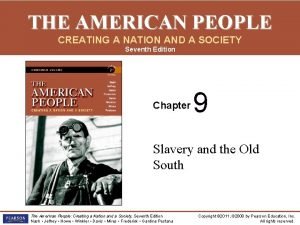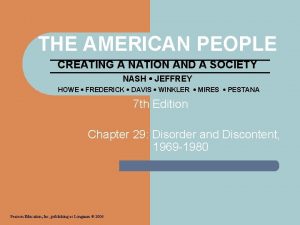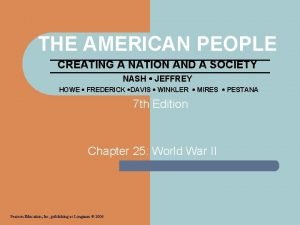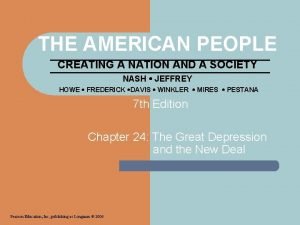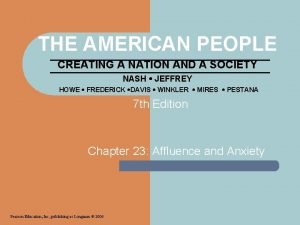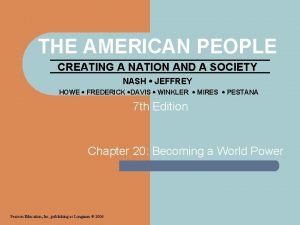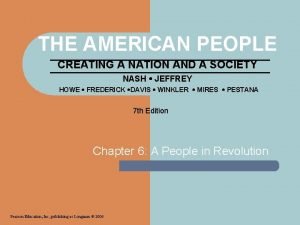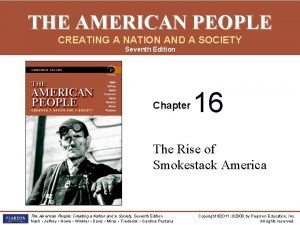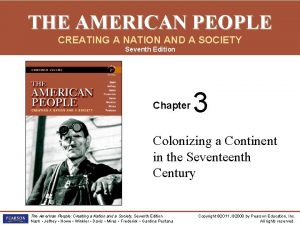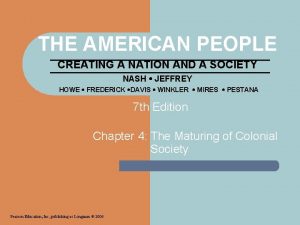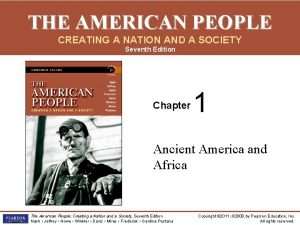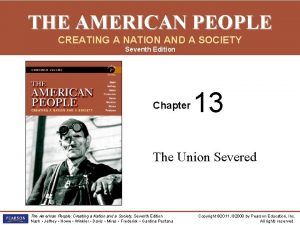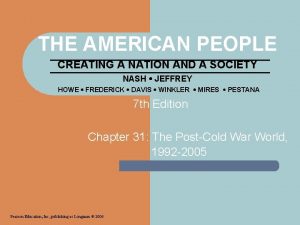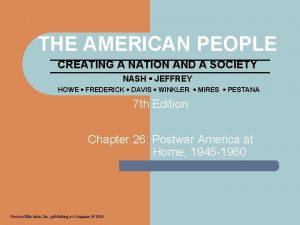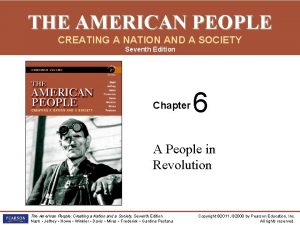THE AMERICAN PEOPLE CREATING A NATION AND A










































- Slides: 42

THE AMERICAN PEOPLE CREATING A NATION AND A SOCIETY The Post-Cold War World 1990 -2001

THE CHANGING FACE OF THE AMERICAN PEOPLE l l The continuing influx of new immigrants after 1990 reshaped demographic patters The overall population, as reported in the 2000 census, grew more rapidly than it had in the past several decades

THE NEW PILGRIMS l 17. 5 million immigrants entered the U. S. between 1981 and 2000 with 10 million in the 1990 s alone – – – l l One third of population growth in the 1990 s came from immigrants Most immigrants settled on the West Coast One third of all immigrants, legal and illegal, came from Central America and just over one-quarter came from Asia Faltering economies in their native countries brought most immigrants to America Africans also came to the U. S. for many of the same reasons Illegal immigration remained a problem Influx of new immigrants was spurred by the Immigration Act of 1965 – – – 1986 Congress passed the Immigration Reform and Control Act, aimed at curbing illegal immigration while offering amnesty to aliens living in the U. S. prior to 1982 Immigration Act of 1990 raised immigration quotas while cutting back on restrictions that had previously limited entry and provided for swift deportation for aliens who committed crimes Two other measures in 1992 expanded eligibility


THE NEW PILGRIMS l The scarcity of good jobs and fears of cultural dilution brought increasing resistance from established Americans – – – l l 1992 Californians passed Proposition 187, denying illegal aliens access to public education and medical clinics though a federal judge issued an injunction to prevent its implementation 1996 Congress passed legislation barring illegal immigrants from receiving food stamps and disability assistance from the federal government At the end of the decade, California ended its support for bilingual education Economic improvement at the end of the 1990 s led to pressure to increase the number of visas for high-tech workers while a coalition of business groups and immigrant-rights organizations pressed for admitting more unskilled workers who could take unfilled jobs in the service sector INS received criticism for returning Elian Gonzales and for its policies in the wake of the September 11 attacks


THE CENSUS OF 2000 l 2000 Census reported a 13 percent increase in the nation’s population for a total of 281. 4 million people – – l Rate of growth accelerated in the 1990 s as a result of immigration and longer life expectancy with the total US population reaching 190. 8 million in 2003 Growth was greatest in the West U. S. remained 69 percent white, 12 percent African American and 11 percent Latino Nationally the Asian and Pacific Islander population increased by 43 percent while whites were no longer the majority in California Many Americans in the 2000 Census wanted to identify themselves as multiracial



ECONOMIC AND SOCIAL CHANGE l l American economy improved dramatically in the 1990 s yet many Americans remained poor and homelessness became an increasingly visible problem Groups pushing for equality made gains but still faced resistance

BOOM AND BUST l American economic growth during the 1990 s was not as remarkable as it was during the 1950 s but was still impressive given the context of economic failures in other countries – – – l Stock market soared with some 50 percent of the population owning stocks – l l Promotion of big business during the Reagan era spurred investment an led to significant economic expansion as large firms grew larger and more involved in the global economy Lowering of interest rates led to increased consumer spending Productivity rose steadily and national economic growth rate began to rise even as unemployment declined A lot of investment was in high tech There was a dramatic reduction in the budget deficit though the national debt remained high American companies embarked on a wave of mergers that often resulted in worker layoffs

BOOM AND BUST l In 2000 the stock market began to slide and by 2002 many people had lost their paper gains – – – l Nation’s overall growth rate began to slow as investment declined A recession began in 2000 as a tax cut further undermined economic stability by rewarding the rich but doing nothing for anyone else By early 2001, it was clear the economy was slumping as manufacturing fell to its lowest point in 10 years and unemployment rose Outsourcing increased at an alarming rate Reports of corporate greed and managerial fraud further undermined confidence in the economy Overall union membership continued to fall though there was an increase in public employee union membership

POVERTY AND HOMELESSNESS l In 1997, 35. 6 million people in the U. S. lived below the poverty line – – l Figure equaled one out of every three working Americans In 2004, Department of Agriculture reported that 12 million American farmers struggled to feed themselves Record number of Americans lacked health insurance Urban Americans had the toughest time as people moved to the suburbs and the tax base declined leaving cities without the funds to meet service needs Gap between rich and poor increased significantly in the 1980 s and 1990 s – – Minorities and women continued to lose ground faster than the rest of the population even as the wealthy increased their overall share especially as the new century started Number of homeless quadrupled in the 1980 s and increasingly there seemed no way out

AGING AND ILLNESS l l The population of America continued to live longer and healthier lives as the century concluded Many older Americans objected to mandatory retirement rules – – – l l 1978: retirement age was raised from 65 to 70 1986: amendments to the Age Discrimination in Employment Act prohibited mandatory retirement on the basis of age 2005 Supreme Court ruling held that a worker suing to reverse age discrimination did not have to prove the employer acted intentionally As the population aged, there were increasing problems keeping the social security system solvent Alzheimers increasingly affected the aging population while AIDS struck all ages and all countries, especially in Africa – In 2003 President Bush committed the United States to triple its commitment over the next 5 years to try to counter AIDS in Africa


MINORITIES AND WOMEN FACE THE TWENTY-FIRST CENTURY l African Americans saw home ownership and employment figures rise while the number of murders and other violent crimes involving blacks fell and a record 40 percent attended college – – – l School segregation remained a problem Incidents such as Rodney King made people wonder how much progress had really been achieved Police still stopped African Americans and Latinos more than other groups Faced a backlash in affirmative action with both legislation such as California’s Proposition 209 and Supreme Court rulings Booming job market in the 1990 s was the most important factor in fostering better race relations Women were increasingly involved in academic programs and professions though in almost all areas there was still resistance to women holding the top jobs – – Abortion remained a polarizing issue with opponents receiving more support under the Bush administration Women increasingly disassociated themselves from the feminist label though the movement continued especially in Europe

MINORITIES AND WOMEN FACE THE TWENTY-FIRST CENTURY l Latinos population spread further and faster than any previous immigrant wave – – – In 2000, 46 percent of Latinos owned their own home, an increase of 4 percent since 1990 but still below the national average of 66 percent In 2003, Latinos became the nation’s largest minority group The emergence of a sturdy middle class gave Latinos a greater voice in social and political affairs with Latino political figures becoming more numerous and visible The Latino unemployment rate varied with the economic health of the country though it remained higher than the average and caused more hardship since many unemployed Latinos did not qualify for benefits Median household income fell, eve as it rose for other groups Latinos had a growing impact on American culture

MINORITIES AND WOMEN FACE THE TWENTY-FIRST CENTURY l Native Americans found they had less influence, in part because of their smaller numbers – – – l Continued their legal efforts to regain lost land pressed successfully for the return of their ancestors skeletal remains with the aid of the Native American Graves Protection and Repatriation Act of 1990 Indians remained underrepresented at many universities though with the proper support new opportunities did become available Native American women became increasingly active in the larger reform effort Many Native Americans still felt a sense of dislocation In the last months of the Clinton Administration, the head of the BIA apologized for the nation’s repressive treatment of Indians Asian Americans enjoyed real success in the 1990 s – – Asian children enjoyed remarkable academic success and made up a disproportionate share of the students at the most prestigious universities While they had a higher median income than white, newcomers still faced serious economic problems and racial stereotypes


MINORITIES AND WOMEN FACE THE TWENTY-FIRST CENTURY l The struggle for gay rights continued and in 2000 GM, Ford and Chrysler announced health-care benefits for partners of gay employees and Vermont recognized same-sex relationships through civil unions – – – 2002: American Academy of Pediatricians announced its support of the right of gay men and women to adopt the children of their partners as gay activism helped broaden the definition of family Resistance to gays playing a more visible role in society persisted and the Supreme Court ruled that Boy Scouts could bar gay troop leaders The issue of gay marriage was among the most polarizing

DEMOCRATIC REVIVAL l 1990 s saw a Democratic revival in politics as they reformulated their message and learned to use the media – l Reflected similar shifts in the rest of the world Bitter partisan fighting resulted from Democratic control of the White House and Republican control of Congress

DEMOCRATIC VICTORY l A youthful Bill Clinton stood in stark contrast to incumbent President George H. W. Bush in 1992 – – l H. Ross Perot ran as a third party candidate Campaign was fought on television and resulted in a Clinton victory with 43 percent of the popular vote and 357 electoral votes Clinton wanted to check Americans’ cynicism about government and appointed a cabinet with four women, four African Americans and two Latinos – – – Gained ratification of the North American Free Trade Agreement (NAFTA) in November 1993 Secured passage of a crime bill banning the manufacture, sale or possession of assault weapons Failed to win approval of health-care reform efforts

REPUBLICAN RESURGENCE l In the midterm elections of 1994, Republicans argued that government regulations were hampering business and costing too much while also challenging the notion that the federal government was primarily responsible for health care and other services – l Swept both houses of Congress and did well in a number of states Election marked the end of the commitment to the welfare state as Congress moved to scale back the role of the federal government, eliminate environmental regulations, cut funding for educational programs, reduce taxes and balance the budget – – Gutted the National Endowment for the Humanities, the National Endowment for the Arts and the Public Broadcasting System While conflict over the budget led to the temporary shut down of the government and while the House passed most measures, the Senate balked on a number of them and Clinton vetoed others so that only a few actually became law

A SECOND TERM FOR CLINTON l In 1996, Bill Clinton ran for a second term against Bob Dole – – Clinton reshaped his image and announced the end of “big government, ” coopting Republican issues, pledging to balance the budget, and signing a welfare reform bill that slashed benefits and removed millions of people from the rolls even as he posed as the protector of Medicare and other programs threatened by the Republicans Won a resounding victory over Dole though the Republicans retained control of Congress

PARTISAN POLITICS AND INDEPENDENCE l Clinton had been accused of having engaged in an improper sexual relationship with Monica Lewinsky, a White House intern – – – l Congress, nevertheless, continued its proceedings and impeached the president on counts of perjury and obstruction of justice – l Clinton initially denied the relationship but as additional evidence surfaced, he admitted it The Republican Congress considered impeachment and devoted much energy to the process of removal even though most Americans outside Washington approved his job performance even while condemning his personal choices In the midterm elections, Republicans maintained their margin in the Senate but found it reduced in the House by 5 seats In 1999 the case moved to the Senate where, after weeks of testimony, Clinton was acquitted Overall, Clinton was an enormously successful politician

THE SECOND BUSH PRESIDENCY l Republicans regained control of the White House in 2000 with their candidate George W. Bush who promised to return morality and respect to the White House

THE ELECTION OF 2000 l The campaign between Al Gore and George W. Bush revolved around what the government should do with the federal budget surplus – – l l Election night results showed neither candidate had the 270 electoral votes needed to win with the votes in Florida enough to tip the balance The state became a battleground as a recount began and the sides argued over what should be counted and how and accusations of racism surfaced as Democrats charged that in certain areas African Americans had been prevented from voting The Supreme Court, in Bush v. Gore overturned the Florida court’s decision to allow the recount to proceed and effectively handed the victory to Bush by a 5 -4 ruling despite Gore’s victory in the popular vote The voting in congressional races was equally close resulting in an evenly split Senate though the Republicans ran all the major committees and retained control due to the vice president’s tie breaking vote – – Five months after the session began, Senator Jeffords left the Republican party, throwing control to the Democrats In the House, Republicans had a 9 seat majority

THE NEW LEADER l George W. Bush liked to provide the broad outlines of policy while leaving the details to others – – While his communication skills were not those of Reagan, he did demonstrate a dogged determinism Bush used propaganda skillfully

PROMOTING THE PRIVATE SECTOR l Bush had the interests of corporate America at heart and his first priority was a tax cut which was enacted by mid-2001, lowering tax rates for everyone, allowing more tax-free money for education and reducing estate taxes though, in the end, it mainly benefited the wealthy – l l Economy continued to falter and a full-blown recession ensued Although Bush wanted to reduce the size of government and proposed to slash health care spending, he actually proposed increasing defense spending Bush allowed road building in national forests, reversed bans on snow mobiles in national parks, sought to shrink legal protections for endangered species, eased environmental restrictions on the coal industry and proposed looser standards for mercury emissions – – Dismissed reports that fossil fuel emissions contributed to global warming Spring 2003 the Interior Department announced that no longer would 200 million acres of land be designated as wilderness and protected from development


A SECOND TERM FOR BUSH l The 2004 election was bitter and contentious as Bush faced John Kerry – – – l Both candidates raised huge amounts of money and engaged in attack ads thought he Republicans were more successful Bush won with 51 percent of the popular vote and a modest electoral majority Republicans added to majorities in both the House and the Senate Bush moved quickly to reform the Social Security system by allowing people to invest part of their retirement money in private retirement accounts – – Members of both parties resisted the efforts which critics said would leave millions of workers vulnerable to market fluctuations Despite growing budget deficits, Bush’s proposed 2005 budget contained additional tax cuts

FOREIGN POLICY IN THE POSTCOLD WAR WORLD l l Due to communication advances, the world was more closely linked than ever In the new atmosphere, new questions arose about the role of the United States

THE BALKAN CRISIS l Ethnic and religious violence escalated in the Balkans in the 1990 s – – l In Bosnia, Bosnian Serbs liquidated opponents and engaged in mass killings and rape In mid-1995 a NATO bombing campaign forced the Bosnian Serbs into negotiations and a peace conference at Dayton, Ohio, led to a commitment of U. S. troops, along with soldiers from other countries, to stabilize the area In 1999, Kosovo descended into war as the Serbian leader Slobadan Milosovic, attempted to squelch a movement for autonomy – – NATO launched an American led bombing campaign and Milosevic engaged in “ethnic cleansing” before succumbing He was arrested in 2001 and brought to the Netherlands for trial

THE MIDDLE EAST IN FLAMES l On September 13, 1993, PLO leader Yasser Arafat and Israeli leader Yitzhak Rabin signed a peace agreement that led to Palestinian self-rule in the Gaza strip – – – l In 1995, signed a further agreement and the Israelis handed over control of the West Bank of the Jordan River to the Palestinians A treaty between Jordan and Israel brought peace on that front as well 1998 Clinton facilitated an agreement leading to the return of land in the West Bank area to the Palestinians in return for peace between Arafat and Benjamin Netanyahu, the Israeli prime minister following Rabin’s assassination by extremists The level of Middle East violence at the beginning of the twenty-first century was worse than it was before – – – Short-sighted Israeli policy of building settlements in occupied Arab lands and the Palestinian unwillingness to compromise culminated in an escalation of bloodshed Bush was reluctant at first to intervene though was forced to do so as violence became worse Tended to side with Israel

Siege in the West Bank

AFRICAN STRUGGLES l Africa suffered a series of never-ending crises made worse by the AIDS epidemic which ravaged the continent – – Bill Clinton became the first American president to make an extensive trip to Africa, though his efforts to intervene in Somalia resulted in several dozen American casualties and caused a removal of American troops by 1993 despite the continuing disorder US did nothing to stop a genocide in Rwanda where Hutus killed hundreds of thousands of Tutsis and moderate Hutus George W. Bush was much less interested in Africa and did not attend a conference on sustainable development held in South Africa in 2002 US did little when Robert Mugabe appropriated white land gave it to blacks, precipitating a crisis in Zimbabwe

RELATIONS WITH RUSSIA l US continued to try to promote democracy and capitalism, working closely with Boris Yeltsin and his successor Vladimir Putin – – Russia remained unstable Bush developed a close working relationship with Putin

TERROR ON SEPTEMBER 11 l On September 11, 2001, three hijacked airplanes slammed into the World Trade Center Towers in New York City and the Pentagon in Washington, DC – – – l The towers collapsed and all together 3000 people died though a fourth plane was prevented from reaching its target when the passengers fought back and caused the plane to crash in a field in Pennsylvania The hijackers were Muslim extremists belonging to the al Qaeda network run by Osama bin Laden and furious at the U. S. over its Mideast policy as well as hating American materialistic and affluent values Attacks shattered American sense of security Bush put together a worldwide coalition and launched a bombing campaign in Afghanistan to smoke out bin Laden and his network – – The bombing, followed by a ground invasion, unseated the Taliban but failed to capture bin Laden An international coalition worked to rebuild Afghanistan and Hamid Karzai headed the new government though instability remained

TERROR ON SEPTEMBER 11 l Bush’s approval ratings soared and he created a new Department of Homeland Security to help prevent further attacks – – – l In the Patriot Act, he invoked terrorism as a reason to allow the government to encroach on individual liberties in the name of security American Muslims were often the victims of the government effort In 2002, Bush spoke out against an “axis of evil” consisting of Iraq, Iran and North Korea, and insisted that an invasion of Iraq was necessary to stop their production of weapons of mass destruction In March 2003, with British support but without the UN, Bush launched an attack on Iraq and declared victory six weeks later – – In December, soldiers captured Saddam Hussein but resistance to American occupation continued In mid-2004 approached, Sunnis, Shiites and Kurds fought each other for their share of power, while remaining united in their opposition to the continuing American presence Insurgent attacks against American troops and Iraqis in new official positions continued even as photographs of American abuse of prisoners at Abu Ghraib aroused resentment around the world By mid-2005, the American death toll had surpassed 1800 and opposition mounted at home


DISCOVERING U. S. HISTORY ONLINE United States Census http: //www. census. gov/main/www/cen 2000. html l The Landscape of Asian America http: //www. asian-nation. org/index. shtml l U. S. Department of Labor, Bureau of Labor Statistics http: //www. bls. gov/ l Homelessness Programs and the People They Serve http: //www. huduser. org/publications/homeless_tech. html l William Jefferson Clinton http: //www. clintonlibrary. gov/ l William J. Clinton Presidential Library and Museum http: //press-pubs. uchicago. edu/founders/ l Investigating the President: the Trial http: //www. cnn. com/ALLPOLITICS/resources/1998/lewinsky/ l

DISCOVERING U. S. HISTORY ONLINE Election Collection 2000 http: //web. archive. org/collections/e 2 k. html l George Walker Bush http: //www. potus. com/gwbush. html l A Nation Challenged http: //www. nytimes. com/pages/national/dayofterror/ l Understanding Afghanistan: A Land in Crisis http: //www. nationalgeographic. com/landincrisis/ l War in Iraq http: //www. cnn. com/SPECIALS/2003/iraq/ l Picturing the Century: One Hundred Years of Photography from the National Archives http: //www. archives. gov/exhibits/picturing_the_century/ l The Twentieth Century http: //www. cnn. com/SPECIALS/1999/century/ l
 The american people creating a nation and a society
The american people creating a nation and a society Creating a new nation
Creating a new nation Chapter 6 creating a nation
Chapter 6 creating a nation Chapter 6 creating a nation
Chapter 6 creating a nation Nation state vs nation
Nation state vs nation Nation vs state
Nation vs state Nation vs state
Nation vs state American nation textbook
American nation textbook Holt american nation
Holt american nation Chapter 5 african american in the new nation
Chapter 5 african american in the new nation American nation chapter 4
American nation chapter 4 American nation chapter 4
American nation chapter 4 Folk nation
Folk nation Five point star gang
Five point star gang Surenos rules
Surenos rules What is people as media and people in media
What is people as media and people in media In the usa the big cia
In the usa the big cia Tomer owns a daycare
Tomer owns a daycare Hát kết hợp bộ gõ cơ thể
Hát kết hợp bộ gõ cơ thể Ng-html
Ng-html Bổ thể
Bổ thể Tỉ lệ cơ thể trẻ em
Tỉ lệ cơ thể trẻ em Gấu đi như thế nào
Gấu đi như thế nào Tư thế worm breton là gì
Tư thế worm breton là gì Chúa yêu trần thế
Chúa yêu trần thế Kể tên các môn thể thao
Kể tên các môn thể thao Thế nào là hệ số cao nhất
Thế nào là hệ số cao nhất Các châu lục và đại dương trên thế giới
Các châu lục và đại dương trên thế giới Công của trọng lực
Công của trọng lực Trời xanh đây là của chúng ta thể thơ
Trời xanh đây là của chúng ta thể thơ Mật thư tọa độ 5x5
Mật thư tọa độ 5x5 Phép trừ bù
Phép trừ bù Phản ứng thế ankan
Phản ứng thế ankan Các châu lục và đại dương trên thế giới
Các châu lục và đại dương trên thế giới Thể thơ truyền thống
Thể thơ truyền thống Quá trình desamine hóa có thể tạo ra
Quá trình desamine hóa có thể tạo ra Một số thể thơ truyền thống
Một số thể thơ truyền thống Cái miệng xinh xinh thế chỉ nói điều hay thôi
Cái miệng xinh xinh thế chỉ nói điều hay thôi Vẽ hình chiếu vuông góc của vật thể sau
Vẽ hình chiếu vuông góc của vật thể sau Biện pháp chống mỏi cơ
Biện pháp chống mỏi cơ đặc điểm cơ thể của người tối cổ
đặc điểm cơ thể của người tối cổ V. c c
V. c c Vẽ hình chiếu đứng bằng cạnh của vật thể
Vẽ hình chiếu đứng bằng cạnh của vật thể
